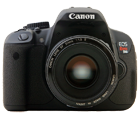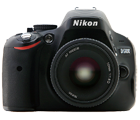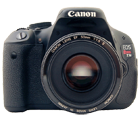Olympus E-330 GuidePosted in April 2006 This Olympus E-330 guide will introduce you to a digital SLR camera that is one-of-a-kind. For now, at least. The Olympus E-330 is the only digital SLR camera as of April 2006 to include a live preview of the image you're about to take on the LCD. This might come as a surprise to you. After all, every compact digital camera on the market provides a live preview on the LCD so you can compose photos without looking through the viewfinder. But this is not a common feature on digital SLR cameras. With all other digital SLRs, you have to look through the viewfinder to see what photo you're going to take. The LCD will show you the photo after you take it, but not before. |
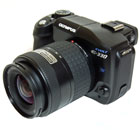 |
Quick Overview
- 7.5 megapixels lets you make 11x14 inch prints
- Compatible with any 4/3 lens
- 3 photos per second
- ISO settings from 100 to 1600
- Maximum shutter speed of 1/4000 of a second
- 2 times crop factor
- 2.5" flip-out LCD
- Stores photos on Compact Flash and xD memory cards
- 3-area autofocus system
Key Feature
The defining feature of the Olympus E-330 is the live LCD preview.
The camera uses a pentaprism like other digital SLRs to reflect the image entering the lens up to the viewfinder.
When you look through the viewfinder of the E-330, you see exactly what the lens sees, one of the advantages of a digital SLR camera.
The trick is that Olympus has included a second digital sensor in the reflected light path.
This sensor is also able to see what the lens sees.
With the push of a button you can activate the sensor and use the LCD instead of the viewfinder to compose your photos.
But wait...there's more.
The LCD also flips out from the camera body, so you can take photos at high and low angles and still easily see the LCD to frame your shots correctly.
This makes the Olympus E-330 an exceptionally versatile camera, and allows for a wide range of photo opportunities that would be hard to capture with any other digital SLR.
Who The E-330 is For
The Olympus E330 is best suited for four types of photographers: landscape, street, child and event.
I think that the Olympus E-330 is the best digital SLR for landscape photography. I won't get into that here - you can click the link to find out more about that.
Street photographers enjoy taking candid portraits (typically on the streets of large cities like New York and Chicago) when the subject isn't aware.
With any other digital SLR, you have to hold it up to your face to get a shot. It's clear to anyone walking past that you're taking a photo.
But with the live LCD preview AND the capacity to flip up the LCD screen (so you can hold the camera at waist level), you can be much more subtle about your street photography.
The ability to take photos at waist level means that you can snap portraits of your child at his or her eye level without getting down on the ground yourself ![]() .
.
If special event photography is what gets you going, the E-330 lets you hold the camera above your head and take shots of the main event right from the middle of a crowd.
In Comparison
In this section of the Olympus E-330 Guide, I'll compare the camera to other similar models.
This is a bit tricky, since the Olympus splits the difference between consumer digital SLR cameras like the Minolta 5D, Canon 350D and the Nikon D50, and the higher-end models like the Nikon D200 and Canon 30D.
While it is more expensive than the other consumer cameras, I will compare it to them since its features and performance are similar.
You can read more about digital SLR camera prices if you're not sure about the different price levels.
Self-Cleaning Sensor
I've already talked a lot about the unique qualities of the LCD in this Olympus E-330 Guide.
The camera also has another feature that is exclusive to Olympus digital SLR cameras: a self-cleaning sensor.
Dust has always been the bane of digital SLR cameras. When you remove the lens on a digital SLR, you expose the sensor to dust.
Once a tiny particle of dust lands on the sensor, it shows up in all of your photos as an ugly round spot.
This is not easy to get rid of.
Cleaning a digital SLR sensor can be done at home, but if you're not in a dust-free environment you run the risk of adding even more dust particles to the sensor than the one already there.
You can get the sensor professionally cleaned, but you'll have to pay for it.
The Olympus E-330 saves you from all of this. The camera includes the Olympus Supersonic Wave Filter, a system that clears the sensor of dust particles every time you turn the camera on.
Does it work? It's hard to tell without intentionally exposing the camera to dust and then seeing how well the wave filter cleans it.
That's not a test that I was willing to try out.
Suffice to say that other cameras don't come with this technology, so if you do get dust on the sensor of a Nikon or Canon you'll have to find a way to clean it off.
Shape and Weight
The Olympus E-330 is not as small or as light as either the Canon 350D or the Pentax *ist line of cameras.
It is a solid, heavy brick of a digital SLR.
The camera doesn't have the same shape as other digital SLRs, since the viewfinder is off to the left instead of positioned on top of the camera.
The reduction in height does make it easier to slip this camera into and out of a camera bag.
The flip-out LCD does stick out from the back of the camera more than LCDs on other cameras and the only drawback here is that you will smudge it a lot with your fingers and nose.
There is a simple solution to the smudging: buy a sheet of transparent film and cut it to the size of the LCD.
Once in place, you can smudge the protecting film all you want.
The LCD is also very easy to clean with a lint-free cloth.
Complicated Menus
If there is one drawback to the Olympus E-330, it's this: the menus are plentiful and complicated.
Let me put it another way: this is the first digital SLR I have ever used where I had to refer to the user manual several times.
The camera is packed with features, which is not surprising since this camera costs more than other comparable consumer digital SLRs.
While you gain a lot of control over every single camera setting, you have to go three menus deep just to change some of them.
If you don't see yourself adjusting your camera settings a lot, then this won't be a problem for you. Set the camera up once, and then don't use the menus again.
Since I like to fine-tune my camera settings depending upon the light and the subject I am photographing, I spent a lot of time scrolling through menus looking for the setting I wanted to change.
The good news is that the most common settings you'll want to change a lot like ISO, white balance and shooting mode (one-shot, continuous or timer) are all available from one-touch buttons on the back of the camera.
Non-Standard Image Size
One of the innovations on the Olympus E-330 is that it uses a new lens mount system called Four Thirds, which is intended as a new standard for digital SLR cameras.
The idea is that you can use any Four Thirds lens on any Four Thirds camera, regardless of who makes the lens and who makes the camera.
The system is also optimized for digital, which means that Four Thirds lenses are lighter than a standard lens, and optimized for the digital sensor vs. film.
But there's an issue when it comes to making standard size prints.
Four Thirds cameras produce images at that size: what is called a 4 to 3 ratio (or 4:3). Regardless of your units of measurement, one side of the image is a multiple of 4 and the other is a multiple of 3.
I'll use inches, since this also relates to print size.
The most common print size is 4x6 inches, since this is the aspect ratio of standard 35mm film (6:4 or 3:2). A Four Thirds image is not the same aspect ratio as a 4x6 print.
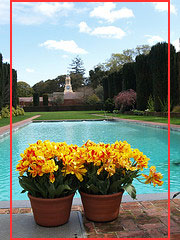
Every photo that you print at 4x6 will be cropped.
The top and bottom of horizontal images will be cropped, and a little bit of the left and right of vertical images will get left behind on the cutting room floor.
This image to the right shows you the dimensions of a 4x6 print relative to the size of the image created by the E-330. Anything outside the red box will be cropped when you print photos at 4x6.
On the plus side, the 4:3 ratio is a LOT better if you want to make large-scale prints. You can read a more in-depth analysis of aspect ratio if you'd like to find out why.
How It Works
This section of the Olympus E-330 Guide tells you what it's like to take this camera out into the world and snap photos with it.
The Olympus E-330 is more challenging to get started with than other digital SLRs.
The rechargeable battery needs charging time before it's ready to go, and I've already mentioned the complicated menu system.
Since the only setting you have to worry about to get started is the date and time, you can set those and then find a good program mode to stick with while you're getting used to the camera.
Even though there is a learning curve associated with the E-330, once you're going you'll find that you can take a wide variety of photos with this camera.
In Use
Taking photos with the Olympus E-330 is a unique experience.
The live LCD adds a whole new dimension to digital SLR photography - I'll talk about that more in just a moment.
The camera has three autofocus points, and it focuses quickly even when there is not a lot of ambient light.
Despite its fast focus response, this is not the ideal camera for action photographers since it can only store about 4 photos in its buffer (internal memory) before it slows down.
Live LCD
Click to open and close the viewfinder.
It's strange for an SLR photographer to be freed from the viewfinder, able to compose photos at any angle and still get a well-framed shot.
I found it liberating.
There are two modes for the live LCD display on the Olympus E-330. In A mode, the LCD displays the preview and you can also look through the viewfinder.
The viewfinder can be closed with a small lever, and Olympus recommends that you do this when using A mode to prevent stray light from entering the camera.
I deliberately left the viewfinder open in A mode for some shots in broad daylight and could not tell the difference from shots where the viewfinder was closed.
In B mode, the camera locks up a mirror inside the camera, which effectively blocks your view through the viewfinder. This mode ensures that no light enters the viewfinder, but it won't work if you want to switch back and forth from LCD to viewfinder.
Once you choose either A or B mode for the live preview, you can activate it with a button on the back of the camera.
With the LCD active you can go to town.
There are several benefits to an LCD that you can view from high and low angles, some which might not be immediately obvious.
For example, I enjoy taking shots of fountains using slow shutter speeds so that the water turns to glass.
Slow shutter speeds usually result in blurry photos when there isn't a tripod right at hand.
With the Olympus E-330, I was able to brace the camera against solid objects, yet still compose the image using the LCD - no strange body contortions required.
I also used the LCD to photograph my son.
One of the "rules" of child photography is to get down at their level. Child photos taken from above make them look small and insignificant ![]() .
.
Rather than getting down on my hands and knees for each shot (which is what I do with other digital SLRs) I was able to snap away from a standing position, yet keep the camera right at his eye level ![]() .
.
I didn't have the opportunity to use the E-330 in a crowd, but this would be a prime time to leverage the ability to capture well-framed photos even when holding the camera above your head.
Color
The E-330 has more color modes than you can shake a stick at.
I tried to use as many as I could for this Olympus E-330 guide, and you'll be seeing sample photos scattered throughout this section.
First, the color controls on the E-330 allow you to make precise adjustments depending on your preferences.
"Vivid" is the default mode, but if this is creating colors that are too vibrant, you can tone things down by switching to "Natural".
If you want to eliminate color entirely, you can go with either the black and white mode ![]() or sepia
or sepia ![]() .
.
In both of these modes you can simulate the effect of a red, yellow or blue filter on the monochromatic image.
Just keep in mind that if you switch the color mode, the camera doesn't default back to color for you. There were several times where I caught myself taking black and white shots when what I really wanted was color.
Flash
The E-330 flash works just like it does on other consumer digital SLR cameras, with one noticeable difference.
With other SLRs set to automatic or program mode, the flash will pop up automatically when the camera detects that there isn't enough light.
Not so with the E-330.
Even in program mode, you have to make sure that you pop the flash up if you want to use it in dim light.
The flash features several different modes, including red-eye reduction.
You can also adjust the flash output, if you want to increase or decrease the amount of light the flash puts out.
Batteries
When you first get the camera, don't think that you can go running out and take some photos: it takes 5 hours to charge the battery the first time.
Recharges don't take quite as long, but you can't get the battery to a full charge in a half hour so you have to be prepared once it runs out.
And it will run out, much faster than other digital SLR camera batteries.
This is due to the large size of the LCD and the fact that you are using it all the time to compose photos.
Other digital SLR cameras conserve battery life by using the LCD (a power hog) in a limited fashion.
On the Olympus E-330 the LCD is the star of the show, but prolonged use means that you use up your battery faster.
Simple solution: get a second battery.
Lenses
There are not a huge number of lenses that you can use with the E-330, since old Olympus lenses are incompatible with the new 4/3 format.
For some this is bad news, for others it couldn't be better.
If too many choices sets your mind reeling, then having less lens options to choose from is going to make life simpler.
But don't wait too long.
Lens manufacturers are hard at work developing new 4/3 lenses, so in a couple of years there might just be as many of these lenses as there currently are for Canon and Nikon.
Kit Lens
The standard kit lens for the E-330 is a 14-45mm zoom.
It provides a slightly wider angle of view than other kit lenses (they run from 18-55mm), but this doesn't have a lot of impact since the Olympus four thirds sensor is smaller than the sensors in other comparable cameras.
This means that the E-330 has a higher crop factor (2x instead of about 1.5x) which makes this lens frame like a 24-90mm lens on a 35mm camera.
By way of comparison, the 18-55mm lens on the Canon 350D frames like a 29-88mm lens on a 35mm camera.
This wide angle of view is great for capturing scenic vistas, which makes it ideal for landscape photographers.
The kit lens includes a lens hood, which prevents lens flares ![]() when you're taking photos outside in sunlight.
when you're taking photos outside in sunlight.
This is a nice included feature, since the lens hood doesn't cost very much.
Additional Lenses
Maybe you've decided that the kit lens isn't right for you, or you just want a second lens.
If you don't know lens jargon and aren't sure how to pick one, read the guide to digital SLR lenses first.
For everyone else, here are some alternative lenses for the E-330.
| TYPE | MAKER | LENS | PRICE |
| Macro | Olympus | 50mm f/2.0 | $ 440.00 |
| Telephoto Zoom | Olympus | 50-200mm f2.8-3.5 | $ 865.00 |
| Ultra Zoom | Olympus | 18-180mm f/3.5-6.3 | $ 500.00 |
| Super Telephoto | Olympus | 300mm f/2.8 | $ 7,000.00 |
The Pros and Cons
| Pros | Cons |
|
|
Price Analysis
As you can see from the following table the E-330 is priced between consumer digital SLRs (Nikon D50, Canon 350D, etc.) and the more advanced semi-pro models (Canon 30D, Nikon D200).
This makes the E-330 either an expensive consumer camera or a cheap semi-pro camera.
Here's the catch: the E-330 cannot keep up with speed and performance of either the 30D or D200. Both of those cameras will out-shoot the E-330 any day of the week.
This means that the Olympus E-330 is more of a consumer camera, which places it at the expensive end of the price range.
| MAKER | CAMERA | PRICE |
| Nikon | D50 with 18-55mm lens | $ 627.00 |
| Minolta | Maxxum 5D with 18-70mm lens | $ 700.00 |
| Canon | EOS 350D with 18-55mm lens | $ 780.00 |
| Olympus | E-330 with 14-45mm lens | $ 1,040.00 |
| Canon | EOS 30D with 18-55mm lens | $ 1,400.00 |
| Nikon | D200 with 18-70mm lens | $ 2,000.00 |
Accessories
There are quite a few accessories for the Olympus E-330 digital SLR.
This first ones that I list here are practical, and the last one is definitely for a special use of the camera.
Batteries
I mentioned above that you'll want to get an extra battery for the E-330 since the live LCD mode uses so much power.
The E-330 uses an Olympus BLM-01 Lithium Ion rechargeable battery that retails for about $45.00.
Memory Cards
The E-330 uses both Compact Flash and xD picture cards (a proprietary Olympus memory card).
For the Compact Flash cards, you have a lot of options in terms of storage space.
The following table shows how many shots you can get at the different quality settings on a 1GB Compact Flash card.
| CARD | SHQ | HQ | SQ |
| 1 GB | 169 | 536 | 2939 |
I recommend high-speed Compact Flash cards (files are saved faster from camera to card and card to computer) and since the Olympus E-330 packs in 7.5 megapixels, a 512MB or 1GB card is good to have around.
| CARD | SIZE | PRICE |
| SanDisk Ultra II | 512MB | $ 45.00 |
| SanDisk Ultra II | 1GB | $ 60.00 |
| Lexar Pro 80x | 512MB | $ 40.00 |
| Lexar Pro 80x | 1GB | $ 60.00 |
For the Olympus xD picture cards, you have a choice between the 512MB ($ 35.00) or the 1GB ($ 54.00).
Flash
If you want a bit more oomph out of your flash than what the built in flash offers, then consider an external flash.
A external flash alternative for the E-330 is the Olympus FL-36, which retails for about $ 210.00
Camera Case
You can get a fitted semi-hard case for the Olympus E-330 to protect your new digital SLR investment: the Olympus CS3-SH case.
Underwater Housing
Yep, this is the special-use accessory.
You can get a specialized underwater housing for the E-330 so that you can take it diving, up to a depth of 196 feet or 60 meters.
If you're into underwater photography, the live LCD on the back of the E-330 will make composing photos much easier.
The underwater housing for the E-330 is the PT-E02.
For Owners
This section of the Olympus E-330 Guide will help you if you already own the camera and need additional help and resources.
Digital SLR Lessons
Tired of missing great photo opportunities even though you have an advanced digital SLR camera?
I'll let you in on a little secret: there's nothing wrong with your camera.
Digital SLRs are great at taking photos, but not so good at making decisions - it's up to you to know what you want and to take manual control when you have to.
Here's some good news: it's easier to learn how to use your digital SLR than you might think.
In fact, you can learn all about all the features of your Olympus E-330 digital SLR camera in just 5 easy online lessons.
E-330 Manuals
Have you misplaced your manual? Don't have it at hand?
Just use one of the following links to view a PDF file that will explain all of the camera's controls.
Olympus Web Site
These links will help you find what you're looking for on the Olympus web site.
- Olympus Digital SLR Information
- E-330 Specifications
- E-330 Product Support
- Olympus Digital SLR Lenses
E-330 Firmware Update
Firmware updates keep your digital SLR camera operating at its highest potential. Think of them like software updates - minor improvements to the camera's functionality.
In April of 2006, Olympus released a firmware update for the E-330, which addresses the following issues:
- Improvement in image quality when using the macro enlargement in live view mode B
- Macro live view mode B can be used in underwater macro and underwater wide mode
- Changes made for Korean Language
You can get the firmware update for the E-330 from the Olympus web site:
Photo Samples
 |
 |
 |
 |
 |
 |
 |
| Digital SLR Home | Other Camera Guides |









